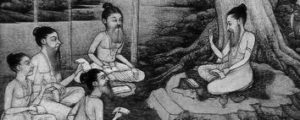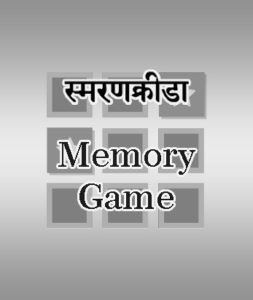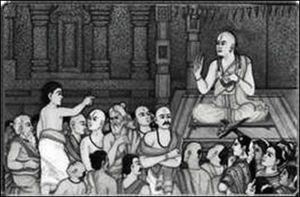This is part two of the paper presented at the international conference New Frontiers in Sanskrit and Indic Knowledge in June 2017 organized by the Chinmaya International Foundation. Part 1 of the paper can be found here.
~
Tool #1. Exposure to Arts and Culture
Just like a child is first exposed to the arts and culture in his environment, it is valuable for the learner of a language to be exposed to the cultural milieu of the language. One who seeks to learn Sanskrit will greatly benefit from the following activities:
- Watching classical dance performances[1] and theatre productions of traditional Indian plays[2]
- Listening to classical music[3], specifically those with a focus on the lyrics
- Participating in festivals[4] and rituals[5] – be it at the house-level, community-level or the societal level
- Visiting temples[6] and other centres of culture, especially as part of a pilgrimage journey[7]
- Reading Indian storybooks that have episodes from the Purāṇas and the Itihāsas[8]
The greatest benefit of this process is the sheer enjoyment derived from it. If a learner decides to discontinue even at this stage, it wouldn’t be a waste. The cultural immersion one gets from this process is invaluable. One will be exposed to the treasures of stories from the Indian epics and Purāṇas, which will later have a bearing on learning and writing kāvya. The lyrics (in musical compositions) and dialogues (in plays) will give a feel for the tonality of the sounds of Sanskrit, as will the various mantras recited at the rituals or stotras sung at temples. With this feel for the tonality, learning the pronunciation and phonetics of the language becomes easy.
Tool #2. Listening to the Language
Listening is an integral part of the learning process. The learner can begin by listening intently to Sanskrit compositions and repeating them. The typical process is that the teacher—or in this case, perhaps an audio clip—recites the verse once and the student repeats it twice. The verses chosen for this segment are stotras[9] and subhāṣitas[10] that are free from anvayakleṣa (complicated word order). The reason for choosing such verses—stotras and subhāṣitas—is primarily that they are self-contained and give a complete picture of a typical Sanskrit sentence, i.e. they have all the constituent elements of a sentence, like noun, verb, etc.
The basic group of verses is confined to five poetic meters— anuṣṭup, āryā, upajāti, vasantatilakā, śārdūlavikrīḍita—whose gati (rhythmic pattern) is naturally suited to Sanskrit. Verses composed in these meters are typically free of anvayakleṣa. Later, when the learner attempts composing in meter, he would do well to start with these five.
The next group of verses is chosen in order of metrical length. Starting with the vaṃśastha meter, the learner can move on to longer varieties, in the following order: praharṣiṇī, ruchirā, puṣpitāgra, aupacchandasika, mālinī, pañcacāmara, viyoginī, mandākrantā, śikhariṇī, hariṇī, pṛthvī, sragdharā, aśvadhāṭi, and daṇḍaka.
Listening and repeating classical verses ensures that the gati of the chandas is firmly established in the learner’s mind. This will later help in metrical composition. Doubtless, one will learn the pronunciation of Sanskrit words, but this process also gives the learner an intuitive understanding of sandhi. Further, if the learner is able to commit to memory several of these verses, it will be beneficial in myriad ways.
Tool #3. The Sanskrit Alphabet
It is important to learn the sounds of the individual Sanskrit letters and repeat them before learning the orthography. The pronunciation of the letters in sequence will give an intuitive grasp of the vargīkaraṇa (classification based on the places of origin of sounds) of the Sanskrit alphabet. Once the learner is familiar with the alphabet, this phonetic structure will be explained in detail.[11]
Historically, the Sanskrit language has been written down in multiple Indic scripts but with the advent of printing technology, the devanāgarī script became ubiquitous. However, to this day, Sanskrit texts can be seen printed in the Kannada, Telugu, or Malayalam scripts. In recent times, the IAST (International Alphabet of Sanskrit Transliteration) has become popular. In many cases, it might be sufficient to learn IAST but it is beneficial to learn the devanāgarī script since many Sanskrit works are not available in IAST.
After learning the Sanskrit alphabet, both in pronunciation and in the written form (in devanāgarī), the student is introduced to the numbers in Sanskrit.
Tool #4. Vocabulary and Grammar
The traditional method to develop a strong vocabulary is to memorize the Amarakoṣa of Amarasiṃha (c. 4th century CE). Even today, this is a great tool for Sanskrit learners. This ancient thesaurus has been composed entirely in the anuṣṭup meter and is therefore easy to remember. While memorizing will be ideal, one may choose to listen and repeat the verses. By learning the Amarakoṣa, the learner will immediately become familiar with twelve thousand
Sanskrit words. A good grasp of synonyms will make composition easier for the learner.[12]
If the learner wishes to have a grasp over the basics of Sanskrit grammar, the following aspects must be studied well: nāmapada (noun forms), kriyāpada (verb forms), sandhi (euphonic combination), samāsa (compounding of words), kāraka (case relationships), upasarga (prefixes), avyaya (indeclinables), pratyaya (affixes and suffixes), and prayoga (voice).[13]
Tool #5. Traditional Training
The ancient saying, ‘Śataślokena paṇḍitaḥ’ indicates that a student who went through the eight-fold path of traditional training for one hundred verses was considered a pundit. While this might be an exaggeration, this rigorous and time-tested procedure enables the learner to approach any work of classical Sanskrit without any external help.
A good set of hundred to begin with is the ‘Saṅkṣepa Rāmāyaṇa,’ the first hundred verses of the epic Rāmāyaṇa. Having studied these verses in the traditional method, the learner can then select verses from the works of Kālidāsa and Bhartṛhari. Having become familiar with these, the learner can proceed to more complicated works, like those of Māgha, Śrīharṣa, and Nīlakaṇṭhadīkṣita.
Tool #6. Engagement with Literature
The starting point for engagement with literature can be the reading out of plays. In the order of complexity, the learner can read aloud the following works:
Level 1: Karṇabhāra, Svapnavāsavadatta, Ūrubhanga (Bhāsa)
Level 2: Avimāraka (Bhāsa), Mālavikāgnimitra, Abhijñānaśakuntala (Kālidāsa)
Level 3: Mṛcchakaṭika (Śūdraka), Uttararāmacarita (Bhavabhūti), Mudrārākṣasa (Viśākhadatta)
Upon reading out loud the aforesaid plays, the learner will get a sense of dialogue and usages. This will be the foundation upon which the student can mould his conversational skills. Using the materials prepared by Samskrita Bharati, the learner can begin to hold basic conversation in Sanskrit as well as develop a vocabulary of the common, day-to-day objects (in Sanskrit).[14] Care has to be taken that the idiomatic flavour of Sanskrit should not be sacrificed for short-term convenience.[15] It is particularly important that the learner constantly practices speaking in Sanskrit.
The student can explore different formats of Sanskrit literature for a deeper understanding of the language. Needless to say, he can appreciate the language in many more ways.
Stories:
Kathāsaritasāgara (Somadeva)
Pañcatantra (Viṣṇuśarma)
Vetālapañcaviṃśati (Śivadāsa)
Bhojaprabandha (Ballālasena)
Epics:
Rāmāyaṇa (Vālmiki)
Mahābhārata (Vyāsa)
Poems:
Raghuvaṃśa, Kumārasambhava, Meghadūta (Kālidāsa)
Madhurāvijaya (Gaṅgadevi)
Bhallaṭaśataka (Bhallaṭa)
Kirātārjunīya (Bhāravi)
Prose:
Kādambarī, Harṣacarita (Bāṇa)
Campu (a combination of prose and poetry):
Campu Rāmāyaṇa (Bhoja)
Nīlakaṇṭhavijayacampu (Nīlakaṇṭhadīkṣita)
Viśvaguṇādarśacampu (Veṅkaṭādhvari)
While none of aforementioned lists are exhaustive, the authors are of the opinion that these works will give a basic foundation in Sanskrit with which the interested learners can approach any work of classical Sanskrit literature. However, a mere knowledge of Sanskrit might not be sufficient for reading through a work in a specialized śāstra, just like knowledge of English does not automatically equip a person to read a book on a nuanced subject like, say, Archaeo-genetics.
Tool #7. Games
Games are an excellent way to lighten the learning process and reinforce some of the concepts through innovative means. While several games—particularly with the use of technology—can be devised, we can also draw from some of the ancient pastimes of India[16]. Based upon the pre-requisites for playing the games, they are best categorized according to the aforementioned tools. Here is an illustrative list:
Listening to the Language:
What’s the meter? – Identifying the poetic meter of a given verse.
Pratimālā – Popularly known as antyākṣarī, this memory-based game is played between two people (or teams). Person A recites a verse. Person B recites a verse that begins with the last syllable of the previous verse. This goes on until one of them is unable to recall a verse with the specific syllable.
The Sanskrit Alphabet:
What’s the letter? – Matching the sound with the script.
Word building – Played between two people. Person A gives out a syllable (vowel or consonant). Person B builds on it by adding another syllable, ensuring that there is a possibility of a word. The person who utters a syllable that completes a word is the loser. The objective is to explore the language.
Vocabulary and Grammar:
Synonym builder – Given a word, one has to come up with as many synonyms as possible within sixty seconds.
Flash cards – With a view of strengthening the learning of noun and verb declensions, two-sided cards are used. Using the information on one side of the card, the learner has to figure out what is on the other side. For instance, if one side of the card has “rāmasya” with the note: “Give the liṅga-vibhakti-
vacana of the word,” then the other side has “a-kārānta-puṃliṅga-rāma-śabdaḥ ṣaṣṭhīvibhaktiḥ ekavacanam” with a note: “Give the noun declension.”
Traditional Training:
Pictionary – A popular game that involves one person drawing and the other person(s) guessing the word depicted through the picture. Also the word can be used to recall a verse having that word or about that word. This game can be used not only to identify a Sanskrit word but also an entire verse.
Dumb charades – Another popular game that involves one person acting out in mime and the other person(s) guessing the word acted out. Again, the word can be used to recall a verse.
Prahelikā – An ancient game of riddles. Typically by splitting the words differently or taking alternative meanings for a word(s), the riddle is solved.
Engagement with Literature:
Story building – A creative game that involves Person A giving out a sentence.
Person B builds upon it and gives out another sentence. Going ahead in this manner, a story is constructed.
Samasyāpūrṇa – An ancient lateral thinking game that involves the questioner giving a line of a verse—typically the fourth—which is either obscene or meaningless and the contestant composing the other three lines in such a manner as to remove the obscenity and/or render the verse meaningful.
Dattapadi – A traditional game of composing a verse using specific sounds chosen by the questioner. The contestant is given four words—often in a totally different language—and is expected to use those words in the same order, one in each line of the verse. Additional constraints involve specification of poetic meter and theme of the verse. To ensure the linguistic feasibility of such a construction, the questioner himself has to have composed a verse under the exact same constraints.
Tool #8. Exercises
Every Sanskrit pedagogy comes with a set of exercises aimed at evaluating the students’ understanding. Rarely, such exercises are also graded so that the questions get harder as the learner progresses. Exercises are perhaps inevitable to the learning process but we can certainly make them less taxing and burdensome to the learner. Drawing out a detailed set of exercises is beyond the scope of the present work, but a broad outlook to the structuring of exercises is attempted here.
The exercises (and the answers provided by the student) should necessarily be in Sanskrit. These exercises should be graded in terms of difficulty. It is ideal if the questions are fewer in number and are devised in an investigative frame, resembling popular puzzles. These will have to be composed in such a manner that all aspects of the topic at hand are covered. Further, such questions will help improve the reading comprehension of the learner. The questions can be presented in both oral and written formats. Similarly, the learner may choose to answer in either media. Since all this is in Sanskrit, the student begins to think in the language, which is the acme of language learning.
Additionally, translation exercises to and from Sanskrit will benefit the learner in the modern context since there is ample requirement for translations.
Learner Profiles
People who seek to learn Sanskrit typically fall into one of these four groups:
- The Neophyte: A newcomer, who has never encountered the language. It is also possible that he knows nothing about the Indian cultural heritage.
- The Urbanite: A person who is familiar with the Indian ethos but is unfamiliar with literature in any Indian language.
- The Insider: Someone who is familiar with both the cultural heritage of India and the traditional literature in one or more Indian languages.
- The Alumnus: A learner who has formerly studied the language, either formally or otherwise, and wishes to reconnect with it.
The learning tools may be employed appropriately for these learner profiles. The first six learning tools are ordered in logical sequence with the previous tool essential for the commencement of the next. The last two—games and exercises—will be a part of every step of learning. These make the learning process more enjoyable and well-grounded.
The Neophyte will have to undergo the training meticulously if he wishes to attain proficiency in the language.
The Urbanite too will have to follow all the steps but given his background, he may be able to go through some sections faster.
The Insider will already have a good exposure to Indian art and culture. He has possibly heard a fair bit of Sanskrit in his environment already. He may have to learn the devanāgarī script but will already be familiar with the alphabet.[17] His knowledge of one or more Indian languages would have already bestowed a fairly strong Sanskrit vocabulary, so he may begin with the rudiments of grammar. He may also choose to directly begin with the traditional training tool and refer to grammar texts as and when needed. With the confidence gained from the training, he can proceed to literature.
The Alumnus, having learnt the language earlier, will perhaps be in a position to chart out his own course of study, using the learning tools the manner in which he finds suitable to his needs. Nothing specific need be prescribed for such a learner.
The first and second groups can follow a ‘familiarity approach,’ which doesn’t expect them to memorize large chunks of words but instead helps them get familiarized gently with the language. The third and fourth groups may perhaps choose a ‘rote approach,’ which is more efficient but expects them to memorize a fair deal and persist in their engagement with the language.
Levels of Proficiency
Based on the learner profiles, having employed the learning tools appropriately, the student is expected to reach a basic level of proficiency in Sanskrit. Depending on the learner’s interest, he may choose to improve his skills in the language and take it to an advanced level. The tools have been designed in such a manner that they easily lend themselves to all levels. Broadly we can identify three levels of proficiency:
- Basic: The learner can hold simple conversations in Sanskrit, identify letters, recite five verses each in ten poetic meters, read and understand a basic text like Saṅkṣepa Rāmāyaṇa, and compose a hundred-word essay about oneself or one’s surroundings.
- Intermediate: The learner can have lengthy conversations in Sanskrit, recite ten verses each in twenty poetic meters, read and understand classical Sanskrit works like those of Kālidāsa, write a thousand-word essay on a given topic, and compose verses in the anuṣṭup
- Advanced: The learner can give a public speech in Sanskrit, recite twenty verses each in twenty poetic meters, read and understand any work of classical Sanskrit, write a long-form essay on a given topic, and compose verses in at least five poetic meters.
Irrespective of the learner profile, the student can choose to reach any one of the three levels of proficiency based on his needs. In order to get his own learning whetted in a formal setting, he may choose to appear for a test at his preferred level of proficiency.
Conclusion
Sanskrit is the oldest language in the world that is still in use today. It helps us connect with the oldest known civilization. Just like Sanātana Dharma, Sanskrit is ancient yet relevant. Sanskrit is the most refined language in the world in terms of its structure, which has remained more-or-less unchanged for twenty five centuries.
A glaring lacuna in all the previous pedagogies of Sanskrit education is their refusal to emphasize the aesthetic aspect of the language over all others. In the modern context, it becomes all the more important that we consider the aesthetic factor as supreme. A failure to do so will amount to losing out on the core strength of the language.
The present work tries to fill this gap by providing an approach with a clear emphasis on the literary value of Sanskrit along with the possibility of great customization while astutely drawing on the existing technologies to make the learning more fun-filled and enriching.
Yadeva vidyayā karoti śraddhayopaniṣadā
tadeva vīryavattaraṃ bhavati...
(Chāndogya Upaniṣad 1.1.10)
The authors express their deep gratitude to Shatavadhani Dr. R. Ganesh who has been the sole inspiration to work in this area of Sanskrit education and undertake this study.
Thanks to Shatavadhani Dr. R. Ganesh and Arjun Bharadwaj for their review of the present paper and offering their valuable suggestions for improvement.
Select Bibliography
Anantachar, Chakravarthy. Saṃskṛtavyākaraṇakaumudī. Bangalore: Subhas Publications, 1984.
Bhat, G. Mahabaleshwar. Sandhi. Bangalore: Samskrita Bharati, 2013.
Kale, M. R. A Higher Sanskrit Grammar. New Delhi: Oriental Book Center, 2010.
Iyengar, P. K. Duraiswami. Dhāturūpamuktāvalī. Madras: Law Printing House, 1915.
Jacob, G. A. Laukikanyāyāñjaliḥ. Varanasi: Chowkhamba Vidyabhawan, 2013.
Lanman, Charles Rockwell. A Sanskrit Reader. Boston: Ginn and Company, 1912.
MacDonell, Arthur A. A Sanskrit Grammar for Students. London: Oxford University Press, 1926.
Rao, Y. Subba. Saṃskṛtaprathamapustakam. Holenarsipur: Adhyatma Prakasha Karyalaya, 1934.
Sampad & Vijay. The Wonder that is Sanskrit. Puducherry: Sri Aurobindo Society, 2011.
Shanbhag, D. N. Subodha-saṃskṛta-vyākaraṇa. Dharwad: Bharata Prakashana, 2010.
Sharma, N Ranganatha. Amarasiṃhana Nāmaliṅgānuśāsana athavā Amarakoṣa. Mysore: Kavyalaya Publishers, 2014.
Sriramachandrudu, Pullela. Sanskrit Idioms, Phrases, and Suffixational Subtleties. Tirupati: Rashtriya Samskrita Vidyapeetha, 2002.
Footnotes
[1] Notable examples include Padma Subrahmanyam, Kelucharan Mohapatra, Birju Maharaj, and Sundari Santhanam.
[2] For instance, Abhinaya Bharati’s theatre production of Bhāsa’s Svapnavāsavadatta.
[3] Any lyrical composition sung by M S Subbulakshmi, P B Sreenivas, Ghantasala Venkateswara Rao, etc.
[4] Festivals like Varamahālakṣmī vrata, Gaṇapati utsava, and Navarātri parva.
[5] Rituals like udakaśānti, rudrābhiṣeka, and navagrahahoma.
[6] Temples that are ornately carved and are richly decorated with sculptures will be particularly valuable for the learner.
[7] Pilgrimage centers like Varanasi, Tirupati, and Vaishnodevi.
[8] Perhaps the finest examples include the Amar Chitra Katha series and the Chandamama magazines of yesteryear.
[9] Selections can be made from well-known stotras like Veṅkateśa-suprabhātam, Bhajagovindam, Viṣṇusahasranāma, Śivānandalahari, Mukundamālā, Gaṇeśa-pañcaratna, Dvādaśastotra, Śāradābhujaṅga, Ādityahṛdaya, Śivakavaca, and Viṣṇukavaca. Apart from this, one can also consider Bhagavad-Gītā verses. In general, the writings of Śaṅkara, Līlāśuka, Mūkakavi, Vedānta Deśika, and Yāmunācārya provide ample learning material.
[10] Traditional subhāṣita anthologies include Subhāṣitaratnabhāṇḍāgāra, Subhāṣitāvalī, Subhāṣitaratnakoṣa, and Saduktikarṇāmṛta. The writings of Bhartṛhari and Sundarapāṇḍya are also noteworthy. Modern anthologies are preferable to the older ones; notable ones include Subhāṣitas in two volumes (as a part of the Sahitya Ratna Kosha series published by the Sahitya Akademi), Subhāṣitamañjarī (in Kannada; published by the Kannada Sahitya Parishad), Subhāṣita Sampuṭa (English; published by the Bharatiya Vidya Bhavan), Subhāṣitasāhasrī (in English; selected and translated by Satyavrat Shastri), Bhaktisudhā (published by the Chinmaya Mission).
[11] For example, details such as: the twenty-five vargīya-vyañjanas are divided into five groups based on where the sounds originate – kaṇṭha (throat), tālu (palate), mūrdhā (roof of the mouth), danta (teeth), and oṣṭha (lips).
[12] In addition to listening and repeating the verses of the Amarakoṣa, one can also make use of the excellent exposition (in Kannada) of Vidwan N Rangantha Sharma on the work.
[13] In an earlier section of the paper, a few notable grammar guides have been listed. The learner can pick any of those.
[14] See for example, Saṃskṛtavyavahārasāhasrī (Bangalore: Samskrita Bharati, 2013).
[15] A text like Pañcatantra is a veritable treasure to learn idiomatic Sanskrit. It will give the student a good understanding of vācoyukti (idioms) and laukikanyāya (maxims), which are hallmarks of classical Sanskrit. Selections of prose passages from various plays will also help in this regard.
The student can refer to Pullela Sriramachandrudu’s compilation of idioms (published by Rashtriya Samskrita Vidyapeetha, Tirupati) and the anthology of maxims compiled by G A Jacob (published by Chowkhamba Vidyabhawan, Varanasi).
[16] Many of these are found in the sixty-four traditional arts of India enlisted in the Kāma Sūtra.
[17] With the sole exception of Tamil, which has fewer letters compared to Sanskrit.

















































